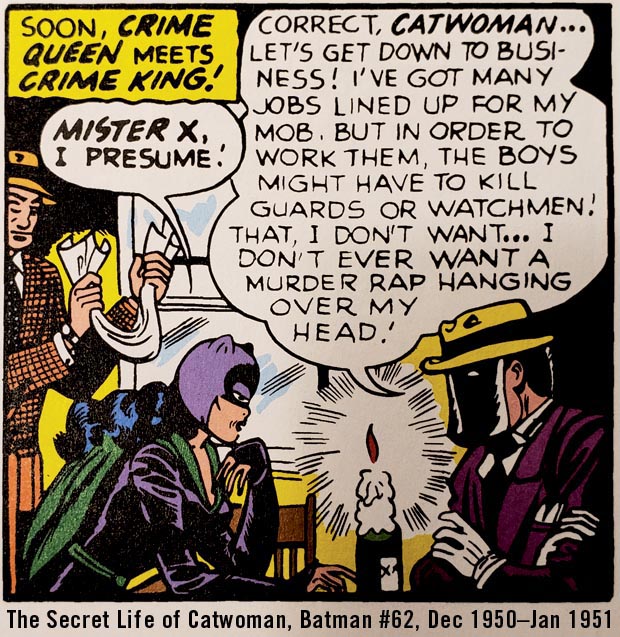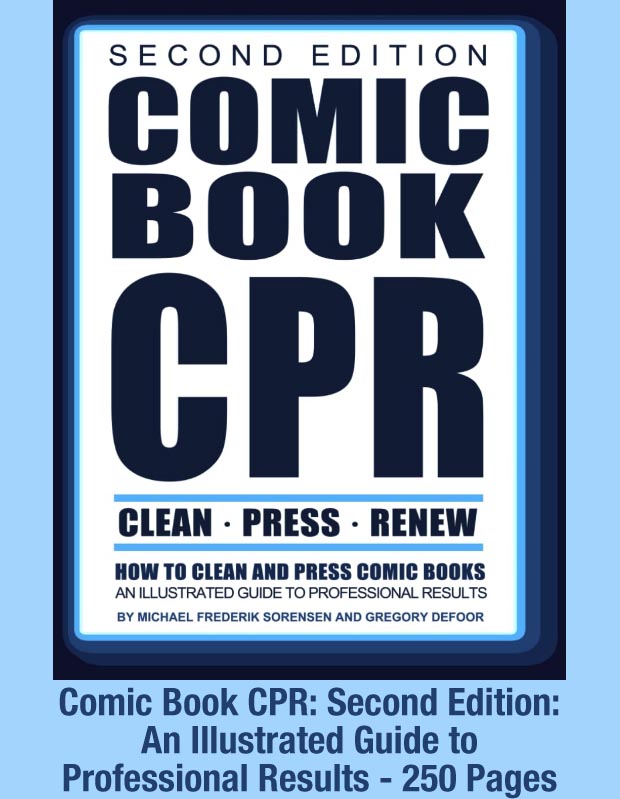Review The Secret Life of Catwoman
Batman #62, Dec 1950-Jan 1951
Written by Bill Finger
Art by Lew Sayre Shwartz and Bob Kane (Batman and Robin figure art)
Inks by Charles Paris

Bill Finger's Catwoman/Selina Kyle of the 1950 The Secret Life of Catwoman isn't a tale from this current century and is thus held to a 20th century attitude on lawbreaking, which means we know that Selina is a criminal and this isn't explained away or dismissed. But, Bill Finger's 1950 story is powered by a sympathetic take on the character that would not have appeared even five years earlier when bad-girl Selina Kyle was simply bad and beautiful.
In the course of the story Batman helpfully gives us an overview of past Catwoman cases (which are also the names of the previous stories Catwoman appeared in) and we get to see that there's a long history of legitimate bad-doings. This doesn't really shock any Batman reader, of course, but it certainly shocks Selina Kyle herself because she's recently been clonked on the head and has come out of an amnesiac spell that has lasted almost five years during which all of these crimes were committed. And how was she struck on the head? By leaping to shove Batman out of the way of a falling building, prompting Robin to exclaim "She risked her life to save you! I don't understand it... Sometimes she acts like the exact opposite!"
How did it come to happen she is saving Batman?
The story begins with her being freed from prison by a mask-wearing mysterious crime-lord named Mister X. His gang dynamites the wall of the prison where Selina is being held, then blindfolds her to be taken to X's secret hideout.
Once there, it is explained to her that she is needed for the purpose of planning a series of spectacular thefts that will not include killing, for, as Mister X explains "I don't ever want a murder rap hanging over my head," and in the criminal underworld, Catwoman is a legend for pulling off high-stakes but homicide-free capers.
After the meeting, we see a sultry Catwoman relaxing in her secret lair in the glow of a blazing hearth-fire, surrounded by cats and contemplating her situation.
She rouses herself to leave and to begin to examine the location where she has to create a plan for the proposed heist sponsored by Mister X. While on her way there, she is spotted by Batman and Robin and is pursued. This is when the decrepit wall collapses, she saves Batman's life and the falling debris knocks her out.
When she is revived she is completely without awareness of the last five years of time. In particular, she draws a blank on her entire career of wrongdoing as "The Princess of Plunder," aka Catwoman. Horrified and in tears from hearing about her criminal past, she readily accepts Batman's plan to now have her operate as a double-agent so that Batman can infiltrate and more easily capture Mister X and his entire gang. Then, in Bill Finger's story, a freak coincidence involving a background character who is similar to Selina Kyle (and Batman!) takes on enormous importance as the tale moves through various robberies being pulled off by Mister X's gang (without Mister X being present) with Catwoman helping, each crime traumatizing to Selina Kyle because she desperately wants to distance herself from this "hateful" life of wrongdoing.
Unfortunately, Batman and Robin are captured by Mister X's gang during one of the robberies, and Catwoman must now act the part of trying to keep Batman and Robin alive while still being a trusted member of the gang. Eventually she is exposed for her sympathy for the two prisoners and ends up tied to a farm tractor about to be sent hurtling over a cliff into the sea.
For only being 12 pages, The Secret Live of Catwoman packs in a lot of story, and Bill Finger gets to work into the tale a giant typewriter (giantized everyday objects being a Finger specialty) for Batman and Robin to leap about on, plus his affection for the femme fatale Catwoman is obvious, too.
In a way this is more familiar to 21st century comic book and comic book based-writing, which is, the author is infatuated with the female arch-villain they're writing about. Though this villainess may pile up a body count and run rampant over everyday laws and morals, she is still somehow very interesting, beautiful, and it's all somehow not her fault she's so bad.
Although the tale tames Selina Kyle and seems to end her career as an agent of chaos, the interesting element of having Batman recall so many of her previous crimes reminds us (if we're familiar with the stories) that Catwoman has frequently used alternative identities for her own ends, and though this story ends with Selina Kyle handing her Catwoman costume over to Commissioner Gordon, do we know Selina hasn't simply put on another cover-identity to stay out of jail?
One of the attributes of the Catwoman stories in which she "switches sides" is how a bad girl will start manifesting alarming amounts of good character in between her badness after rubbing shoulders with an attractive hero.
This seems to me to be a tell-tale sign that the author has a crush on their female villain (or at least wants the reader to have one) and imagines, like many an infatuated person, that given enough exposure to the right influences, the object of their affection can be subverted "I can fix her."
The reasoning for this can go in several different directions at once, for example, when a bad woman is attracted to a heroic character who is good, a kind of illumination occurs and the cynical and street-wise villainess develops a growing strain of latent idealism which increases and is headed for a cathartic moment when she obtains the hero as her own, coinciding with sacrificing her faith in badness.
Many other female comic book villains go much further into this contradiction than Bill Finger's Catwoman, with writers putting a sympathetic spin on a villainess, showing us a bad gal's background story and creating a series of mitigating circumstances that makes her criminal activities explainable, and, in the peculiar way of romanticism, pardonable. The result is a bad girl that is full of bad girl attitude who may have built up a victim count of secondary characters and innocent bystanders, however, as far as the writer is concerned, she's somehow not really bad. The character herself may believe she is bad, and other characters in the story may believe she is bad, but the writer and the audience know better. If this sounds morally confusing, its because it is.
But, Bill Finger doesn't get trapped into any of that, and his Selina Kyle is as noble as Batman, in her way, when she is on the right side of the law.
Related: More Reviews!
Review: Harley Quinn vs Zatanna #1 – Fighting in a void
Review: Conan the Barbarian #186 – Conan and a water nymph cooperate on a jailbreak
Batman Family #1, Sept-October 1975 – Batgirl and Robin battle a resurrected Benedict Arnold out to spoil the Bicentennial
Detective Comics #831 - Reforming Harley Quinn June 2007
Brave and the Bold #131, DC Comics December 1976 by Bob Haney with art by Jim Aparo
Review Adventure Comics #423, featuring Supergirl DC Comics Sept 1972
Review: Knight Terrors First Blood #1 DC Comics July 2023
Hell is a Squared Circle by Chris Condon and Francesco Biagini September 2022 AfterShock Comics
Review: Weird Mystery #4, Jan-Feb 1973
The Secret Life of Catwoman, Batman #62, Dec 1950–Jan 1951
The Origin of the Superman-Batman Team - review of World's Finest #94, May-June 1958, art by Dick Sprang
The Spirit Reborn - Review of The Spirit #1, Feb 2007 By Darwyn Cooke
Superman Confidential #1, January 2007 By Darwyn Cooke and Tim Sale
Richard Corben's Edgar Allan Poe – Poe's Haunt of Horror #1, 2006
Bloodstar - 1975 - Richard Corben
House on the Borderland 2000 - by Richard Corben
Review of the Joker Graphic Novel - Brian Azzarello and Lee Bermejo 2003
Review Harley Quinn #55, Feb 2019 - "We'll All Be Home for Christmas"
Edgar Allen Poe Haunt of Horror #1 2006 - by Richard Corben

Comic Books the Dilemma
Original page February 21, 2023 | Typos fixed August 15, 2023


